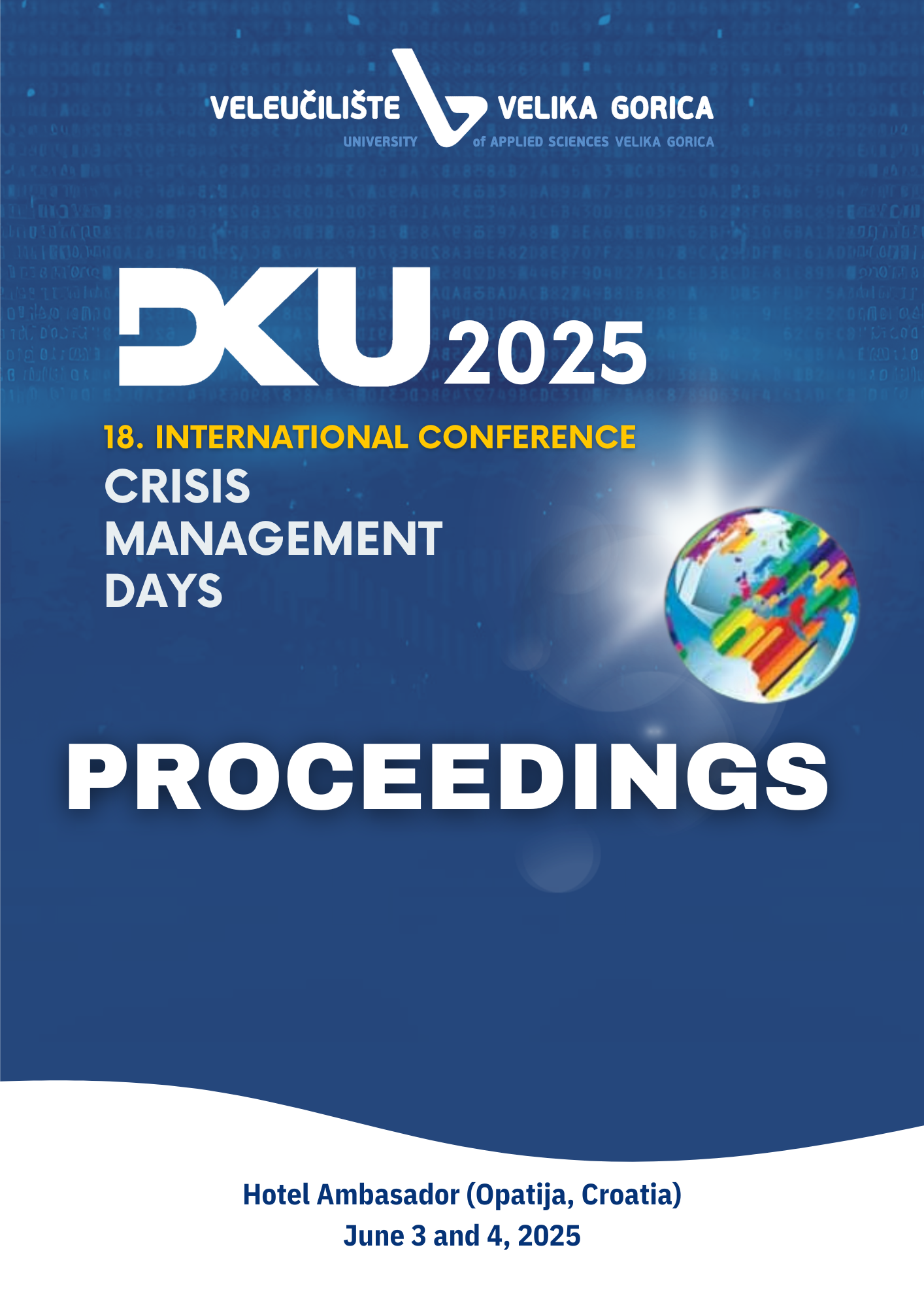Published 2025-11-27
Keywords
- artificial satellites,
- Kessler syndrome,
- space-debris mitigation,
- satellite end-of-life disposal,
- orbital environment
How to Cite
Copyright (c) 2025 Dajana Jelčić Dubček

This work is licensed under a Creative Commons Attribution-ShareAlike 4.0 International License.
Abstract
The increasing reliance on satellite-based technologies for communication, navigation, and Earth observation has led to an unprecedented growth in the number of artificial satellites, particularly in low Earth orbit. Alongside their benefits, this expansion has resulted in a growing accumulation of inactive satellites and orbital debris, raising serious environmental and safety concerns. This review examines the ecological implications of the space debris problem, with particular emphasis on the risks posed by uncontrolled fragmentation, long-term orbital persistence, and cascading collision scenarios such as the Kessler syndrome. Existing and emerging mitigation measures are discussed, including active debris removal technologies and satellite end-of-life protocols. The paper highlights the urgent need to recognize near-Earth space as a vulnerable environmental domain, requiring global coordination and sustained technical innovation to ensure its long-term usability and safety.
References
- Axthelm, R., Klotz, B., Retat, I., Schlossstein, U., Tritsch, W., & Vahsen, S. (2017). Net capture mechanism for debris removal demonstration mission. In Proceedings of the 7th European Conference on Space Debris (Paper SDC7-78), Darmstadt, Germany, 18–21 April 2017. https://spacedebris2017.sdo.esoc.esa.int
- Clarke, A. C. (1945). Extra-terrestrial relays: Can rocket stations give world-wide radio coverage? Wireless World, 51(10), 305–308.
- ClearSpace. (n.d.). ClearSpace-1 mission: Pioneering sustainability beyond Earth. https://clearspace.today/missions/clearspace-1
- Colvin, T. J., & Locke, J. (2024). Exploring the use of a ground-based laser system to deorbit small orbital debris. NASA, Office of Technology, Policy, and Strategy. https://ntrs.nasa.gov/api/citations/20240005687/downloads/2024%20-%20OTPS%20-%20Ground-Based%20Laser%20Debris%20TIM%20v3.pdf
- Copernicus Programme. (n.d.-a). Earth monitoring. https://www.copernicus.eu/en
- Copernicus Programme. (n.d.-b). Sentinel satellites. https://sentinels.copernicus.eu/web/sentinel/copernicus
- European Space Agency. (n.d.-a). Envisat – ESA's environmental satellite. https://www.esa.int/Applications/Observing_the_Earth/Envisat
- European Space Agency. (n.d.-b). Connectivity and secure communications: Orbits. https://www.esa.int/Applications/Connectivity_and_Secure_Communications/Orbits
- European Space Agency. (n.d.-c). Clean Space: Mitigation measures and zero debris technologies. https://www.esa.int/Space_Safety/Clean_Space
- https://www.esa.int/Space_Safety/Space_Debris/Mitigating_space_debris_generation
- European Space Agency. (2025a). Space environment statistics. Environment Report. https://sdup.esoc.esa.int/discosweb/statistics
- European Space Agency. (2025b). ESA’s annual space environment report (GEN-DB-LOG-00288-OPS-SD, Version 9.0, March 31, 2025). ESA Space Debris Office. https://www.esa.int/Space_Safety/Space_Debris/ESA_Space_Environment_Report_2024
- Federal Communications Commission. (2022). Mitigation of orbital debris in the new space age (FCC 22-74). https://docs.fcc.gov/public/attachments/FCC-22-74A1_Rcd.pdf
- Gaston, K. J., Anderson, K., Shutler, J. D., Brewin, R. J. W., & Yan, X. (2023). Environmental impacts of increasing numbers of artificial space objects. Frontiers in Ecology and the Environment, 21(6), 289–296. https://doi.org/10.1002/fee.2624
- Giudici, L., Gonzalo, J. L., Muciaccia, A., Colombo, C., Trisolini, M., & Letizia, F. (2024). Environmental impact of object breakup in medium-Earth orbit. Advances in Space Research, 74(4), 1900–1915. https://doi.org/10.1016/j.asr.2024.06.012
- Inter-Agency Space Debris Coordination Committee. (2025a). IADC report on the status of the space debris environment (IADC-23-01 Issue 3). https://www.iadc-home.org/documents_public
- Inter-Agency Space Debris Coordination Committee. (2025b). IADC space debris mitigation guidelines (IADC-02-01 Rev. 4). https://www.iadc-home.org/documents_public
- Iridium Communications Inc. (n.d.). Staying connected. https://www.iridium.com/
- Kessler, D. J., & Cour-Palais, B. G. (1978). Collision frequency of artificial satellites: The creation of a debris belt. Journal of Geophysical Research, 83(A6), 2637–2646. https://doi.org/10.1029/JA083iA06p02637
- Launius, R. D. (n.d.). Sputnik and the origins of the space age. NASA. https://www.nasa.gov/history/sputnik/sputorig.html
- NASA. (n.d.-a). Sputnik and the dawn of the space age. https://www.nasa.gov/history/sputnik/index.html
- NASA. (n.d.-b). International Space Station. https://www.nasa.gov/international-space-station/
- NASA. (n.d.-c). Hubble Space Telescope. https://science.nasa.gov/mission/hubble/
- NASA National Aeronautics and Space Administration. (2019). NASA technical standard 8719.14B: Process for limiting orbital debris. https://standards.nasa.gov/
- Nicholas, J. (2009). Collision of Iridium 33 and Cosmos 2251: The shape of things to come (NASA Report JSC-CN-18971). National Aeronautics and Space Administration. https://ntrs.nasa.gov/api/citations/20100002023/downloads/20100002023.pdf
- Northrop Grumman. (2020). Space logistics: Our life extension services. https://www.northropgrumman.com/what-we-do/space/space-logistics-services
- OneWeb. (n.d.). Future network. https://oneweb.net/future-network
- Sutherland, W. J., Atkinson, P. W., Broad, S., Clout, M., Coyne, D., Dicks, L. V., ... & Milner-Gulland, E. J. (2021). A 2021 horizon scan of emerging global biological conservation issues. Trends in Ecology & Evolution, 36(1), 87–97. https://doi.org/10.1016/j.tree.2020.10.014
- United Nations Office for Outer Space Affairs. (1967). Treaty on principles governing the activities of states in the exploration and use of outer space, including the Moon and other celestial bodies. https://www.unoosa.org/oosa/en/ourwork/spacelaw/treaties/introouterspacetreaty.html
- United Nations Office for Outer Space Affairs. (2010). Space debris mitigation guidelines of the Committee on the Peaceful Uses of Outer Space (ST/SPACE/49). https://www.unoosa.org/pdf/publications/st_space_49E.pdf
- Wang, T. (2010). Analysis of debris from the collision of the Cosmos 2251 and the Iridium 33 satellites. Science & Global Security, 18(2), 87–118. https://doi.org/10.1080/08929882.2010.493078
- Wikipedia contributors. (n.d.-a). Satellite navigation. Wikipedia. https://en.wikipedia.org/wiki/Satellite_navigation
- Wikipedia contributors. (n.d.-b). Satellite internet constellation. Wikipedia. https://en.wikipedia.org/wiki/Satellite_internet_constellation

